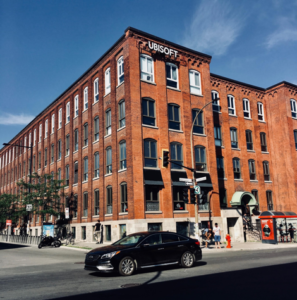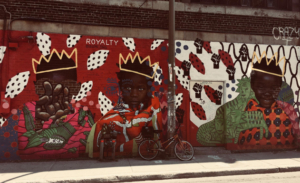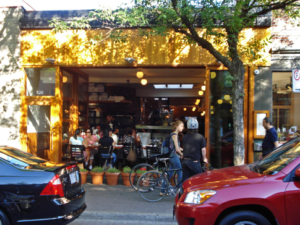Modest storefronts and cafés line the streets of Montreal’s Le Plateau-Mont Royal. Walk down almost any residential avenue and you’ll spot the iconic metal staircases of the neighborhood’s old Victorian townhomes. The borough is also known for its murals that breathe artistic life into its quiet streets—but don’t let the quiet fool you, the Plateau is one of Montreal’s most popular neighborhoods and also the most densely-populated borough in all of Canada. While once a less favorable end of town, a new wave of trendy bars and restaurants have revitalized the Plateau, bringing with them a herd of new residents and higher rents.
The Plateau’s Mile End district—known as Montreal’s creative, cultural hub—is largely at the center of this growth. The Mile End has long been home to Montreal’s bohemian, artistic community including some of Canada’s most beloved musicians, writers and filmmakers such as Arcade Fire, Ariane Moffatt, Sean Michaels, among others.
Photo Caption: Le Plateau-Mont Royal. Photo Credit: Kate Warrington
Now thanks to its growing popularity, the Mile End has expanded to include stylish shops and a food scene that fuses hole-in-the-wall staples like gnocchi served in Chinese take-out containers with newer, more diverse options like organic falafel—a tell-tale sign of modern-age gentrification (next to the opening of a Starbucks). But while the redevelopment of an artistic neighborhood is not a unique story, what differentiates Montreal’s Mile End from New York’s East Village or Portland’s Pearl District are the collaborative efforts of the district’s residents, government officials and developers to maintain the Mile End’s originality and prevent rising costs from pushing artists out.
Where the Artists Go, Others Will Follow
Originally the epicenter of Montreal’s clothing manufacturing industry, the Mile End has evolved from a largely working-class neighborhood to Montreal’s trend-setting, creative hub over the last century. In the 1980s as the Mile End’s clothing manufacturing industry fizzled out, abandoned factories with cheap rents attracted artists from Montreal’s Old City where redevelopment was hiking up costs and forcing artists out of their studios. As a result, by the 1990s a diverse community of musicians, film-makers and artists had made the Mile End their home.
In 1997, the Mile End cemented its heyday as a clothing manufacturing hub in the past by welcoming the French video game developer Ubisoft—in no other than the former building of the district’s leading clothing manufacturer, John W. Peck & Co. With an influx of 3,000 new tech employees, Ubisoft changed the Mile End—inciting a surge of economic growth with local businesses like Ubi Sushi opening to capitalize on the arrival of Ubisoft workers and the growing lunch-rush crowd.
Photo Caption: Ubisoft’s office building in the Mile End. Photo Credit: Kate Warrington
‘Not Again’—Artists Mobilize to Stay in the Mile End
While Ubisoft was good for business, the Mile End’s artistic community knew that the rising rents, increased foot traffic and influx of new residents that all came with the tech company’s arrival were signs that they were at risk of losing the Mile End.
That’s why when Toronto-based developer Allied Properties Real Estate Investment Trust purchased the Peck & Co. building in 2008 and later, two megastructures behind the Peck building—for nearly $30 million more than the buildings had cost just four years prior—the Mile End’s artistic community decided it was time to do something.
Related Articles:
 “ART CAN WIN THE WAR: EMPLOYING THE LANGUAGE OF HUMANITY”
“ART CAN WIN THE WAR: EMPLOYING THE LANGUAGE OF HUMANITY”
by David Labi
 “URBAN ART AND CHAOS WITH VHILS”
“URBAN ART AND CHAOS WITH VHILS”
by Anne Donahoe
Through collaborative efforts artists, residents, politicians and business owners protested against redevelopment in the Mile End. As a result, in 2012, a zoning law passed to restrict the size of tenants in the megastructures to prevent another large company like Ubisoft from joining the district.
Photo Credit: Kate Warrington
While this was a win for the community, it didn’t change the fact that artists were being pushed out of their studio spaces. Prior to Allied purchasing the two megastructures, artists were paying as little as $250 a month, but upon Allied taking over, many received notice that their leases would not be renewed as to make way for commercial tenants.
Mile End representatives continued to negotiate with Allied on behalf of the neighborhood’s artists. Ubisoft even supported the artists’ efforts, stating that while they wanted to expand to the megastructures themselves, they respected the need to be sensitive to the artistic community.
At long last, the Mile End’s artists achieved a groundbreaking victory—a long-term lease agreement with Allied that would protect 208,000 square-feet of gallery and studio space for artists in the megastructures for 30 years, helping to secure the Mile End’s future as a creative hub.
Photo Credit: Montroyaler
The Mile End in Modern-Day
Fast-forward six years to present day and Montreal’s Mile End remains the city’s epicenter of art and culture—largely still thanks to the deal achieved with Allied Properties.
Richard Ryan, the Mile End’s current-day District City Councilor, who helped design policy for the deal was quoted by The Toronto Star saying, “We gave the power to the artists and told them to go and negotiate and, if it works out for the community, we would soften the rules for the building owners. If it didn’t work out we would keep the more severe rules in place.”
The Toronto Star also described the deal as, “a blow against gentrification, the force that shunts aside the creative classes of all great cities when a downtrodden and low-rent district becomes the trendy place to be.”
Photo Caption: View from Mount Royal. Photo Credit: Kate Warrington
While the Mile End today is still known for its creative, bohemian-esque culture, it would be remiss not to mention that the district’s continued popularity has inevitably increased the cost of living and attracted other developers and retailers to the area. While some fear that the original fabric of the Mile End is slowly being unraveled, others embrace the district’s growing diversity. The result is a dynamic, continuously changing community, rooted in its history and exuberantly prideful of its identity—making it no surprise that artists look to the Mile End as a source of inspiration.
While the future of the Mile End may be unclear as the district strives to address the challenges brought about by growth, one thing is for certain—the Mile End is committed to maintaining its cultural significance and is an example of how community collaboration can help keep a rising artistic neighborhood from losing the people who made it so.















